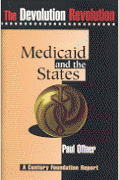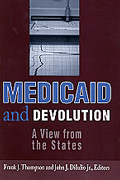This article originally appeared on The Hill on February 24, 2017.
Termites of political disagreement have already chewed through the first plank of the Trump health policy platform — the promise to repeal and replace the Affordable Care Act (ACA, also known as Obamacare). President Trump promised to maintain the gains in insurance coverage achieved under the ACA, lower costs to the insured and spend fewer federal dollars on health benefits.
Belatedly, congressional Republicans and the new administration are realizing that doing all three simply isn’t possible. Now, they are engaged in a party civil war, unable to decide which promise to break. With the release of the most recent version of the Republican health platform, it is becoming clear that the second plank in the Republican health platform—converting Medicaid into a block grant—may also be in deep trouble.
Medicaid is the primary source of health care for more than 74 million Americans. It provides federal matching grants to states if they meet rather modest national standards for provision of health care to qualifying low- and moderate-income households. Together, with Social Security and Medicare — which President Trump promised not to cut — Medicaid is one of the three largest domestic programs. Medicaid spending is projected to total $5 trillion over the next decade.
In 2016, House Republicans proposed two changes in Medicaid that would have cut spending by $2 trillion, or 40 percent, over ten years. One would have rolled back the ACA’s expansion of Medicaid, which 31 states have adopted. The second would have converted the remainder of Medicaid into a block grant, a flat-dollar amount that states could use with even fewer restrictions than they face under the current program.
But what sort of block grant? The traditional variety is a flat-dollar amount that must be used for the broad purpose of providing health care to qualifying recipients, whatever the number. This approach suffers from some serious shortcomings. Most notably, a simple block grant does not respond when a recession causes enrollments to increase, as the current matching grant does.
That is what happened during the Great Recession, and it is the very definition of a safety net. When enrollments rise under a block grant, states are in a bind. They must raise taxes to maintain benefits, cut per-person benefits, deny benefits altogether, or lower other state spending. None of these options are ideal during a recession.
Furthermore, a simple block grant would fall prey to a ‘formula fight’ — a vicious political scrum over which state or congressional district gets which piece of (what in this case would be) a greatly diminished pie. Large differences in current state Medicaid spending, along with the share the federal government will pay, combine to intensify the problem.
Spending varies widely — from $731 to $3,037 per state resident in 2015. Federal grants vary from $1 for each dollar spent in 14 states to more than $2 in 13 states. A large cut in Medicaid spending would force most states to take less. The question is, how much less?
To see the problem, consider two not-randomly-chosen states — Kentucky, represented by Senate Majority Leader Mitch McConnell, and Utah, represented by Senate Finance Committee Chairman Orrin Hatch.
Compared to Utah, Kentucky spends three times more per resident and devotes twice as large a share of its budget to Medicaid. The reason for the difference is that a larger portion of Kentucky citizens have low incomes and bad health than do Utah residents. In addition, Kentucky expanded Medicaid under Obamacare, and Utah did not.
If the challenge just involved negotiations between two Republican barons, a deal would be struck. The problem spans 50 states and 435 Congressional districts, however. Some states would be hit even harder than Kentucky. Other states, like Utah, would be negligibly affected.
So, Republicans decided to put forward a different and more complex block grant under which states would receive different dollar amounts for each of the four categories of Medicaid recipients — the elderly, people with disabilities, children, and non-elderly adults living with children. This approach has two advantages over a simple block grant.
First, the amounts states receive would vary with the number of recipients. So, grants would increase during recessions. In addition, each state’s total would vary with the composition of its Medicaid enrollment. The latter feature is a plus because average Medicaid spending varied in 2015 from $18,518 for people with disabilities to $2,492 for children.
Formula fights would still be unavoidable, however, as state-to-state Medicaid spending within each category varies enormously given the flexibility states enjoy under Medicaid. Funding for elderly recipients ranges from $32,199 per person in Wyoming to $11,431 in Illinois. For children, funding ranges from $5,214 per recipient in Vermont to $1,656 in Wisconsin.
In addition, the proposed formula would create an incentive for each state to pad its rolls. States now get federal matching grants based on what they spend; under the per person block grant, they would receive federal money based on how many people they enroll.
While enrollments might increase, benefits per person would surely decline, as states would be forced to shoulder the full cost of care beyond the much-reduced block grant. The bottom line is that prospects for block-granting Medicaid may well be better than those for repealing and replacing Obamacare. As things stand, that isn’t saying much.










Commentary
Op-edThe Republican health policy agenda is getting more wobbly by the day
February 27, 2017